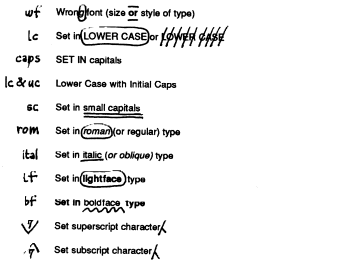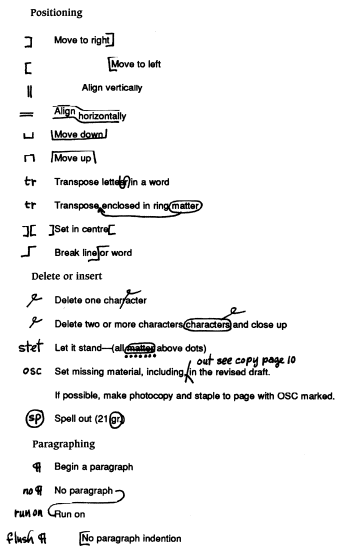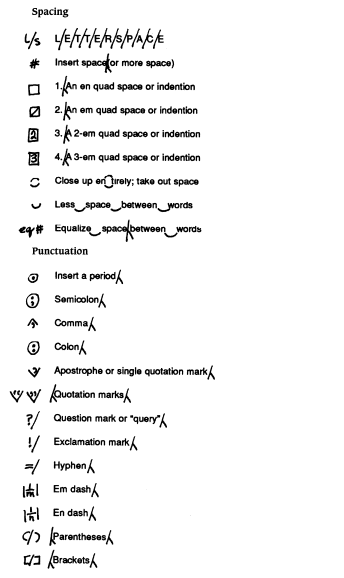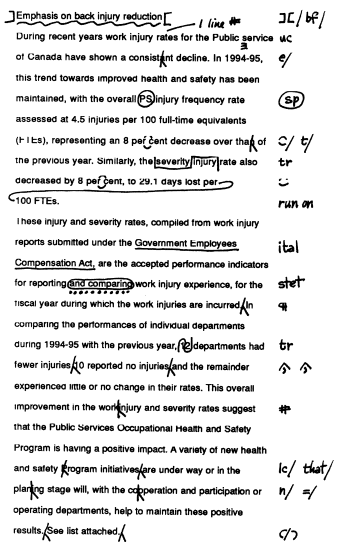
Liens de la barre de menu commune
Liens institutionnels
-
Bureau de la traduction
Portail linguistique du Canada
-
TERMIUM Plus®
-
Chapitres
- + Abbreviations
- + Hyphenation: Compounding and Word Division
- + Spelling
- + Capitalization
- + Numerical Expressions
- + Italics
- + Punctuation
- + Quotations and Quotation Marks
- + Reference Matter
- + Letters and Memorandums
- + Reports and Minutes
- + Usage
- + Plain Language
- + Elimination of Stereotyping in Written Communications
- + Geographical Names
- + Revision and Proofreading
- + French Typographical Rules
Divulgation proactive
Avis important
L’outil The Canadian Style a été archivé et ne sera plus mis à jour jusqu’à son retrait définitif.
Pour obtenir notre contenu le plus à jour, veuillez consulter Writing Tips Plus, un outil combinant le contenu des outils Writing Tips et The Canadian Style. N’oubliez pas de modifier vos favoris!
La zone de recherche et les fonctionnalités
16 Revision and Proofreading
16.01 Introduction
The purpose of this chapter is to give the writer or editor guidance on how to check, correct and improve texts.
Many labels have been attached to the rereading process—revising, editing, reviewing, quality control, quality assurance, checking, post-editing, technical accuracy and conformity test, and so on. In this chapter, we will use the term "revision" to cover the full range of improvements that can be made to the form of a document, including organization of the content.
Revision and proofreading overlap, but proofreading is generally restricted to detecting and correcting omissions, grammar mistakes, and errors in typography, numerical expressions, names and titles, geographical names and addresses, and format. Proofreading for such errors is essential as a final check before distribution; it may also be a cost-effective alternative to extensive revision if time is of the essence.
16.02 Extent of revision
In establishing a revision method, you should keep in mind the time available, the cost of revision, the sensitivities of the person or persons whose work you are about to revise, and above all the end use of the document at hand. A report to be read by a small group of experts for information purposes may require proofreading, not revision, and attention to style and usage will be cursory. In revising a draft of your organization’s annual report, however, you will have to detect, and correct, errors of many different types. Revision in this context may entail making improvements to or even recasting portions of a document which contains few, if any, errors of typography, grammar or usage but which requires changes in style and a reorganization of ideas.
For most purposes, you will deliver a satisfactory product if you eliminate, in accordance with the recommendations in the relevant chapters of this guide, errors of the types listed in 16.05 Sequence. The guidelines presented below are based on the premise that the goal of revision is generally not to rewrite a text or make it conform to the reviser’s personal preferences, but to identify errors and correct them. They may be adapted to fit the specific conditions under which the work is being performed and the end use of the document.
16.03 Preparation
Keep a copy of the unrevised draft. You may decide to reinstate a part of it at a later stage.
If you are revising a print copy of the document, use double or triple spacing, so that your changes are distinct and legible.
Make sure that the required reference tools—dictionaries, style guides, works on usage and grammar, and language data banks—are within easy reach so that you do not waste time looking for them.
If your client has in-house style guidelines or certain spelling, terminology or other preferences, respect them.
Use a checklist, such as the one presented in 16.08 Revision checklist, to organize the revision process efficiently, to ensure that all problems are covered, and to help you meet your deadlines.
16.04 Timing
If time constraints permit, do not start revising your own text immediately after completing the first draft. Following a "cooling-off" period of at least several hours, you will be able to take a fresh look at your material.
Take the time to revise the whole draft; if you adopt a piecemeal approach, it will be difficult to ensure uniformity of style and vocabulary throughout the text, particularly if the draft is the result of a joint effort by several writers.
16.05 Sequence
The steps involved in revision will vary according to individual preference and working conditions. If time is limited, it is important to decide which features of the text should be given priority—style, usage and overall format, or just spelling and grammar. The following sequence is designed to ensure that the process is carried out in a logical, thorough manner. One or more steps may be combined in order to expedite matters, and you may want to take a second look at certain problems or pages requiring further revision or research (see checklist in 16.08 Revision checklist). But keep in mind that the most effective approach is to check for one broad category of error at a time.
(a) Content check
Reread the whole draft for omissions, obvious factual errors, and lack of clarity or illogicality in the flow of ideas. Although not a problem of form, failure to situate each sentence in the context of the whole argument and to ensure that each idea flows logically from the previous sentences and paragraphs is a common shortcoming, which a reviser should detect and, if not correct, at least bring to the attention of the writer.
Rectify any problems, after speaking with the author if necessary. You may have to compare the current draft with an earlier one in order to ensure that no paragraphs, illustrations or tables have been dropped.
(b) Style and usage; plain language
Correct any weaknesses of the types listed below early in the revision process. As in step (a), they may require recasting of parts or all of a sentence or paragraph, as well as significant deletions.
- Unnecessarily long, complex sentences
- Unacceptable neologisms or jargon:
People who are within five years of retirement will be attritted.
- Long multiple-noun phrases
- Verbiage and redundancy ("excessive verbiage"; "countries such as Japan, Indonesia, Malaysia, Singapore, etc.")
- Excessive repetition:
While most job seekers spend fewer than five hours a week looking for a job, job seeking is considered a full-time job in the Job Finding Club.
- Ambiguity
- Improper prepositional usage
- Misuse of a word (see 12.03 Words commonly misused or confused for affect/effect, amount/number and other problems)
- Gallicisms in vocabulary and syntax ("realize a project," "training program of nurses")
- Wrong level of language or style, given end use of document
- Mixed metaphors ("We must put our shoulders to the wheel and take the bull by the horns.")
- Uneuphonic effects:
Presentation of the new provincial prison program will be postponed pending further planning.
(c) Uniform vocabulary
Ensure that only one term is used for the same concept ("eligibility for/admissibility to/right to benefits").
(d) Elimination of stereotyping
Correct any parts of the text that fail to give a fair and representative picture of women, ethnic and visible minorities, Indigenous people and people with disabilities. Here, too, corrections may necessitate structural change.
At this stage the paragraph and sentence structure of the text is to all intents and purposes final. You can begin to check the more technical features.
(e) Names and titles; geographical names; addresses
- Misspelling of a person’s name or failure to adopt preferred spelling
- Failure to use appropriate form of address (The Right Honourable, The Honourable, etc.)
- Erroneous official title (Commission instead of Board, President instead of Chairman)
- Inconsistent presentation of a person’s title
- Wrong English version of a place name
- Use of commas and parentheses in a street address:
168 Radcliffe Crescent
Regina, Saskatchewan
not
168, Radcliffe Crescent
Regina (Saskatchewan)
(f) Spelling; punctuation; hyphenation and compounding; abbreviations; numerical expressions; grammar
Because of deletions and recasting of phrases and sentences, pay particular attention to punctuation, capitalization and grammar. For instance, sentences may lack a verb, an initial capital letter, a co-ordinating conjunction, or an essential punctuation mark. Redundancy may also have been introduced.
The following types of error are commonplace.
- Misspelling
- Misprints
- Punctuation errors, including the overuse of quotation marks
- Incorrect capitalization
- Erroneous compounding or word division
- Failure to ensure that, when first used, an abbreviation follows the full name of the entity it represents, unless the abbreviation is well known
- Incorrect form of an abbreviation
- Inconsistency in presenting numbers (as numerals or words)
- Erroneous or inconsistent use of decimal point
- Inconsistency in presenting SI/metric symbols, including spacing between symbols and figures
- Inaccurate transcription of numbers from one draft to the next
- Arabic in place of Roman numerals, and vice versa
- Non-agreement of subject and verb and use of singular noun where plural is required:
The customer service thrust of this and other departments have been poorly communicated to the general public.
The Tab and Caps Lock key is found on the left-hand side of the keyboard.
- No finite verb:
not
What to do about it?
but
What should we do about it?
- Comma splice:
Cod stocks were dropping at an alarming rate, swift action had to be taken.
(co-ordinating conjunction and required after rate) - Dangling participle:
Omitting the overture, the music began.
Arising out of a conflict of personalities, the Director General, Finance and Administration, felt compelled to resign and move on.
- Faulty or imprecise antecedents for pronouns:
Ross Rebagliati snowboarded down the ski slope, which is now a recognized event in winter olympics competition.
Sam visited his brother every day while he was unemployed.
- Faulty parallelism:
The new sales program was stimulating and a challenge.
( . . . challenging.)
The solution lies not in prohibition or censorship but in developing self-control.
( . . . the development of . . .)
This type of product has three advantages:
- It is strong.
- It is inexpensive.
- Long life. (It has a long life. or It is durable.)
- Misuse of restrictive and non-restrictive constructions (see 7.14 Restrictive/non-restrictive)
- Incomplete constructions (faulty ellipsis):
Aircraft land and take off from Winnipeg airport at very short intervals.
( . . . land at . . .)
The building is as old, if not older than, the Library of Parliament.
( . . . as old as . . .)
(g) Reference notes
- Incomplete references to cited works
- Failure to give a reference for a work cited in the text
- Cross-references leading nowhere
- Erroneous numbering of references
- Too many footnotes per page
(h) Format
- Inconsistent indentation of paragraphs or quotations
- Inconsistent line length
- Inconsistent presentation of headings
- fluctuations between italics, boldface and underlining
- headings randomly centred and placed at left margin
- failure to number sections of document in a logical order
- variable spacing after headings
- Inconsistent use of different type sizes, fonts and typefaces
- Confusion between the letter "l" and the numeral "1" and between the letter "O" and the numeral "0"
- Widows and orphans (see 16.07 Proofreader’s marks(c))
- Non-alignment of columns, particularly in tables
- Too much white space within the body of the text
- Faulty presentation of quotations
(i) Research
If solutions are not readily available, make a note of problems to be resolved and conduct the required research after steps (a) to (h) have been completed. You can thus avoid frequent interruptions to your work.
(j) Final check
Reread the revised text for uniformity and completeness.
See 16.08 Revision checklist for revision checklist.
16.06 Interrevision
In order to ensure that all drafts undergo quality assurance, while at the same time circumventing the constraints and potential conflicts inherent in reviser-writer relations, many professionals exchange texts, alternately drafting their own material and revising that of others. Interrevision makes for variety in activities and provides a fresh look at each document.
16.07 Proofreader’s marks
If you are not responsible for producing final copy and have to indicate your revisions on the draft, you must use proofreader’s marks to help the typesetter or other specialist understand and make the changes required.
If you are proofreading typeset material, you must distinguish between typesetting errors and changes you or the author have decided to make. The mark "AA" (author’s/editor’s alterations) indicates such alterations.
Copy should be at least double-spaced within a 4-cm margin around the text. Proofreader’s marks can be made in red ink in the right-hand space; editing notes can be made in another colour in the left-hand space.
(a) Common proofreader’s marks and their use
Marginal marks are on the left; where required, in-line marks are on the right within the explanatory text.
Style of type



(b) Example of proofread page

(c) Glossary of terms
- Alterations
- Changes made in the copy after it has been set in type.
- Bullets
- Large dots indicating items in a series.
- Composition
- General term for typesetting material.
- Folio
- The page number.
- Font
- A complete set of type of one size and face.
- Italic
- The style of letters that slope forward, in contrast to upright or roman letters.
- Justify
- To adjust spacing in a line so that all lines are of equal length, start at the same point on the left-hand side of the page, or end at the same point on the right-hand side.
- Leaders
- Dots or dashes.
- Letterspace
- The space between letters—usually in display type, headlines, etc.
- Measure
- Width of line of type, always indicated in picas.
- Orphan
- A word or short line standing alone at the bottom of a page.
- Pica
- Unit of measure with 72.27 points to the inch.1
- Point
- There are 12 points to a pica.
- Roman
- A standard or upright typeface.
- Sans-serif
- A typeface without serifs.
- Serif
- The short cross-lines at the ends of the main strokes of many letters in some typefaces.
- Small caps
- An alphabet of small capital letters.
- Stet
- A proofreader’s mark signifying that copy marked should remain as it was.
- Widow
- A word or short line standing alone at the top of a page.
- Wrong font
- The mark "WF" indicates a letter or numeral of the wrong size or face.
______________________
- 1 Errors in pica measurement are made when computer manufacturers round off the pica points to 72 or 6 picas to the inch. Clarification of measurements for team members and production staff will minimize errors.
16.08 Revision checklist
Use a checklist to organize your work, particularly when revising or evaluating long, complex documents. It will help you to cover all pertinent facets of the writing process and to meet your deadlines. The checklist below may serve as a guide; adapt it to fit your specific requirements. When you find problems warranting additional revision or research, indicate the relevant page numbers in the appropriate column (see second column below) for easy reference later on.
Checklist
Content
Start date/time: __________
Target date/time: __________
Date/time completed: __________
| Review item | Page(s) requiring further attention |
Comments |
|---|---|---|
| Factual accuracy | -- | -- |
| Logical flow of ideas | -- | -- |
Style and usage; Plain language; Uniform vocabulary;
Elimination of stereotyping; Names; Titles; Addresses
Start date/time: __________
Target date/time: __________
Date/time completed: __________
| Review item | Page(s) requiring further attention |
Comments |
|---|---|---|
| Factual accuracy | -- | -- |
| Logical flow of ideas | -- | -- |
| Sentence structure | -- | -- |
| Neologisms/jargon | -- | -- |
| Multiple-noun phrases | -- | -- |
| Redundancy/repetition | -- | -- |
| Clarity (ambiguity) | -- | -- |
| Usage/Gallicisms | -- | -- |
| Level of language | -- | -- |
| Metaphors | -- | -- |
| Euphony | -- | -- |
| Uniform vocabulary | -- | -- |
| Stereotyping | -- | -- |
| Personal names | -- | -- |
| Official titles | -- | -- |
| Place names/addresses | -- | -- |
Spelling; Punctuation; Capitalization; Grammar; Etc.
Start date/time: __________
Target date/time: __________
Date/time completed: __________
| Review item | Page(s) requiring further attention |
Comments |
|---|---|---|
| Comments | -- | -- |
| Spelling | -- | -- |
| Punctuation | -- | -- |
| Capitalization | -- | -- |
| Compounding/word division | -- | -- |
| Abbreviations | -- | -- |
| SI/metric symbols | -- | -- |
| Grammar and syntax | -- | -- |
| -- | -- | -- |
| -- | -- | -- |
| -- | -- | -- |
Reference Notes
Start date/time: __________
Target date/time: __________
Date/time completed: __________
| Review item | Page(s) requiring further attention |
Comments |
|---|---|---|
| -- | -- | -- |
| -- | -- | -- |
| -- | -- | -- |
Format
Start date/time: __________
Target date/time: __________
Date/time completed: __________
| Review item | Page(s) requiring further attention |
Comments |
|---|---|---|
| Indentation of paragraphs | -- | -- |
| Quotations | -- | -- |
| Line length | -- | -- |
| Headings | -- | -- |
| Typeface, font, size | -- | -- |
| Widows/orphans | -- | -- |
| Columns/tables | -- | -- |
Final Check
Start date/time: __________
Target date/time: __________
Date/time completed: __________
| Review item | Page(s) requiring further attention |
Comments |
|---|---|---|
| -- | -- | -- |
| -- | -- | -- |
| -- | -- | -- |
© Services publics et Approvisionnement Canada, 2024
TERMIUM Plus®, la banque de données terminologiques et linguistiques du gouvernement du Canada
Outils d'aide à la rédaction – The Canadian Style
Un produit du Bureau de la traduction


